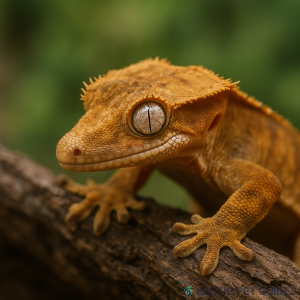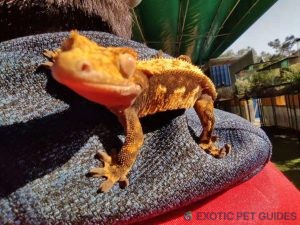Once believed to be extinct, the Crested Gecko (Correlophus ciliatus) has made a remarkable comeback as one of the most beloved pet reptiles in the world. With their expressive eyelashes, low-maintenance care needs, and charming personalities, crested geckos are a top choice for reptile enthusiasts—from beginners to experts.
Whether you’re considering getting one or already have a gecko at home, this guide covers all the essentials for happy and healthy crested gecko care.

🌴 Origins and Natural Habitat
Crested geckos hail from the tropical rainforests of New Caledonia, a group of islands in the South Pacific. They are arboreal (tree-dwelling), nocturnal, and well-adapted to a humid, shaded environment.
They earned their name from the “crests”—skin fringes that run from above their eyes down to their tails. These unique features give them a permanent “eyelash” look that pet owners adore.
📏 Size and Lifespan
- Size: 6–10 inches (including tail)
- Weight: 35–50 grams
- Lifespan: 15–20 years in captivity with proper care
Their manageable size and long lifespan make them a long-term but rewarding commitment.

🏠 Enclosure and Habitat Setup
✔️ Tank Requirements
- Tank Size: 20 gallons minimum for one adult; vertical space is crucial
- Substrate: Coconut fiber, soil blends, or paper towels
- Temperature: 72–78°F (avoid anything above 82°F)
- Humidity: 50–70%, with daily misting
- Lighting: UVB is optional but beneficial, especially for breeding or long-term health
- Decor: Include branches, vines, and hiding spots for climbing and security
💡 Pro tip: Use a hygrometer and thermometer to monitor conditions accurately.
🥗 Diet and Feeding
Crested geckos are omnivores and feed on a mix of fruit and insects.
🍓 Main Diet
- Commercial crested gecko diet (CGD): A complete powder mixed with water; feed 3–5 times per week
- Feeder insects: Crickets or dubia roaches 1–2 times a week (gut-loaded and dusted with calcium)
💊 Supplements
- Calcium with D3: 1–2 times per week if not using UVB lighting
- Multivitamins: Once weekly
Provide a shallow water dish, even though most hydration comes from misting and food.
🧼 Health and Hygiene
🩺 Common Health Concerns
| Issue | Symptoms | Prevention |
|---|---|---|
| Metabolic Bone Disease | Weak limbs, crooked spine | Calcium supplementation, UVB |
| Shedding Problems | Stuck shed, especially on toes | Proper humidity and moist hide |
| Dehydration | Wrinkled skin, lethargy | Consistent misting |
| Tail Dropping | Defensive reaction, tail won’t regrow | Handle gently and reduce stress |
Clean the enclosure weekly and spot-clean daily. Replace substrate monthly if loose material is used.
✋ Handling and Temperament
Crested geckos are generally calm and can be handled after they acclimate.
Handling Tips:
- Handle for short periods (5–10 minutes)
- Let them walk from hand to hand
- Avoid grabbing their tail or sudden movements
They may jump unexpectedly, so always handle them close to a surface.

🎨 Morphs and Colors
Crested geckos come in a wide array of morphs (genetic color and pattern variations):
- Flame
- Harlequin
- Dalmatian (with spots!)
- Tiger
- Patternless
These variations don’t affect care, but they do make each gecko unique in appearance.
✅ Daily Care Checklist
- Mist the tank in the morning and/or evening
- Check temperature and humidity
- Offer fresh food or remove leftovers
- Spot-clean waste
- Observe behavior for any health changes
📝 Final Thoughts
Crested geckos are hardy, beautiful, and surprisingly low-maintenance pets that thrive in the right environment. With just a little daily care, they’ll reward you with quirky behaviors, expressive looks, and years of companionship.
Whether you’re a beginner or a reptile veteran, the crested gecko is a top-tier choice for anyone looking to bring a touch of the tropics into their home.